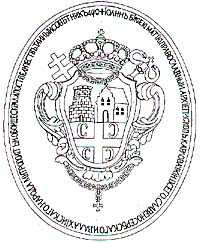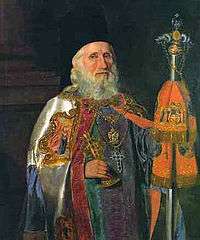Patriarchate of Karlovci
The Patriarchate of Karlovci (Serbian: Карловачка патријаршија, romanized: Karlovačka patrijaršija) or Serbian Patriarchate of Sremski Karlovci (Serbian: Српска патријаршија у Сремским Карловцима, romanized: Srpska patrijaršija u Sremskim Karlovcima), was a patriarchate of the Serbian Orthodox Church that existed between 1848 and 1920. It was formed in 1848, when Metropolitanate of Karlovci was elevated to the rank of patriarchate.[1][2] The Patriarchate of Karlovci existed until 1920, when it was merged with Metropolitanate of Belgrade and other Serbian ecclesiastical provinces to form the united Serbian Orthodox Church.[3] The seat of the Patriarchate was in Karlovci (today Sremski Karlovci, Serbia).
Patriarchate of Karlovci Карловачка патријаршија Karlovačka patrijaršija | |
|---|---|
 Coat of Arms | |
| Location | |
| Territory | Habsburg Monarchy |
| Headquarters | Karlovci, Habsburg Monarchy (today Sremski Karlovci, Serbia) |
| Information | |
| Denomination | Serbian Orthodox Church |
| Sui iuris church | Self-governing Serbian Orthodox Patriarchate |
| Established | 1848 |
| Dissolved | 1920 |
| Language | Church Slavonic Serbian |



History
At the May Assembly in Sremski Karlovci in 1848, the Serbs of the Habsburg Monarchy proclaimed the creation of the Serbian Vojvodina, a Serb autonomous region within the Monarchy. The metropolitan of Karlovci, Josif Rajačić, was also proclaimed "Serbian Patriarch", thus the Metropolitanate of Karlovci became a Patriarchate.[4] The title of "Serbian Patriarch" given to Rajačić was confirmed by the Emperor Franz Joseph I the same year.[5]
This confirmation of Rajačić as the Serbian Patriarch, and Stevan Šupljikac as Vojvoda, was a political move made by Emperor Franz Joseph I. He was confronted with revolution in his country and had difficulties subduing the Hungarians under Kossuth. Šupljikac and his Croatian counterpart, Josip Jelačić supported the Emperor against the Hungarians.[5]
The position of Serbian Orthodox Church and Serbs in Austria and Hungary was regulated in reforms brought about first by Empress Maria Theresa and later by Emperor Joseph II. The Serbian Church-Public Council of 1769 regulated the Serbs and their Church status in a special paper named "Regulament" and, later, in the "Declaratory Rescript of the Illyrian Nation" issued by Maria Theresa in 1779. These acts regulated the life of the Metropolitanate of Karlovci until 1868. Emperor Franz Joseph I published a special edict regulating Serbian Orthodox Church affairs and his edict was in force until the unification of Serbian Churches in 1920.[6]
The establishment of the Patriarchate in Karlovci was seen as restoration of Serbian unity in Austria and Hungary and the patriarch was even considered the ranking personage among the Serbs.[7] Some authors claimed that actually the Habsburg dynasty in Austria founded the patriarchate of Karlovci.[8]
In 1865, the Eastern Orthodox Romanians that were under jurisdiction of the Patriarchate of Karlovci were separated and transferred to the jurisdiction of newly created Romanian Metropolitanate of Sibiu. Process was accomplished by mutual agreement that included the transfer of the Eparchy of Arad and eastern parts of Eparchy of Temišvar and Eparchy of Vršac.
In 1873, Bishopric of Chernivtsi in Bukovina, that was since 1783 under the spiritual jurisdiction of Karlovci, was elevated to the rank of Archbishopric when new Metropolitanate of Bukovinian and Dalmatia was created. New Archbishop of Chernivtsi gained jurisdiction over Serbian eparchies of Dalmatia and Kotor, that also were (until then) under spiritual jurisdiction of Karlovci.[1]
Emperor Franz Joseph I exercised full control over the Patriarchate. In 1890, contrary to the Serb Church Congress ruling and the Orthodox tradition, he promoted Georgije Branković to the patriarchal throne. That way the emperor discredited the Church hierarchy in the eyes of laity and encouraged rise of the anti-clerical Serb People's Radical Party in Austria-Hungary.[9][10]
The last patriarch, Lukijan Bogdanović, was murdered in 1913. After his death, the patriarchal throne remained vacant for the last seven years of its existence, with following bishops serving as locum tenens: Miron (Nikolić) of Pakrac (1913 and 1914–1919), Mihailo (Grujić) of Gornji Karlovac (1913–1914) and Georgije (Letić) of Temišvar (1919–1920; coadjutor 1918–1919).
Following the dissolution of the Austria-Hungary in the autumn of 1918, the Patriarchate of Karlovci was in 1920 merged into the newly united Serbian Orthodox Church under one Serbian patriarch residing in Belgrade.[3]
Eparchies
It included following eparchies:
| Eparchy | Seat | Notes |
|---|---|---|
| Archeparchy of Karlovci | Sremski Karlovci | |
| Eparchy of Buda | Szentendre (Sentandreja) | |
| Eparchy of Pakrac | Pakrac | Now Eparchy of Slavonia |
| Eparchy of Gornji Karlovac | Karlovac | |
| Eparchy of Bačka | Novi Sad | Bačka |
| Eparchy of Temišvar | Timișoara (Temišvar) | |
| Eparchy of Vršac | Vršac | |
| Eparchy of Arad | Arad | Until 1865 |
| Eparchy of Bukovina | Chernivtsi | Spiritual jurisdiction only |
| Eparchy of Dalmatia | Šibenik | Spiritual jurisdiction until 1873 |
| Eparchy of Kotor | Kotor | Spiritual jurisdiction until 1873 |
Patriarchs, 1848–1920
| No. | Primate | Portrait | Personal name | Reign | Title | Notes |
|---|---|---|---|---|---|---|
| 1 | Josif Јосиф Joseph |
 |
Ilija Rajačić Илија Рајачић |
1848–1861 | Archbishop of Karlovci and Serbian Patriarch (1st Patriarch in Karlovci) |
|
| 2 | Samuilo Самуило Samuel |
_p488_MASCHIEREVICS.jpg) |
Sava Maširević Сава Маширевић |
1864–1870 | Archbishop of Karlovci and Serbian Patriarch (2nd Patriarch in Karlovci) |
|
| 3 | Prokopije Прокопије Procopius |
_%D0%B2_1866_%D0%B3%D0%BE%D0%B4%D1%83.jpg) |
Petar Ivačković Петар Ивачковић |
1874–1879 | Archbishop of Karlovci and Serbian Patriarch (3rd Patriarch in Karlovci) |
|
| 4 | German Герман Herman |
 |
Grigorije Anđelić Григорије Анђелић |
1881–1888 | Archbishop of Karlovci and Serbian Patriarch (4th Patriarch in Karlovci) |
|
| 5 | Georgije Георгије George |
.jpg) |
Đorđe Branković Ђорђе Бранковић |
1890–1907 | Archbishop of Karlovci and Serbian Patriarch (5th Patriarch in Karlovci) |
|
| 6 | Lukijan Лукијан Lucian |
Lazar Bogdanović Лазар Богдановић |
1908–1913 | Archbishop of Karlovci and Serbian Patriarch (6th Patriarch in Karlovci) |
Murdered in Bad Gastein under unclear circumstances |
See also
References
- Paul Robert Magocsi: Historical Atlas of Central Europe, University of Toronto Press, 2002
"Then, in 1766, when the Ottomans abolished Pec, the Karlovci province became an independent body, eventually with six suffragan bishops (Novi Sad, Timișoara, Vrsac, Buda, Pakrac, and Karlovac), known as the Serbian Orthodox Slav Oriental Church, which after 1848 was raised to the status of a patriarchate." - Erwin Fahlbusch, Geoffrey William Bromiley (editors): The Encyclopedia of Christianity: J-O Wm. B. Eerdmans Publishing, 2003 page 603
In these territories a Serbian church for "Hungarian" Serbs was set up, elevated to the Patriarchate of Sremski Karlovci by Emperor Francis Joseph in 1848 - Radić 2007, p. 235.
- Barbara Jelavich: History of the Balkans, Cambridge University Press, Jul 29, 1983 page 316
In May 1848 Serbian national assembly attended by several thousand people met in Sremski Karlovci. The delegates chose Josip Rajačić as patriarch and Stephen Supljikac as vojvoda. - Aidan Nichols: Theology in the Russian Diaspora: Church, Fathers, Eucharist in Nikolai Afanasyev (1893–1966) CUP Archive, 1989 pages 49, 242
- Mario Katic, Tomislav Klarin, Mike McDonald:Pilgrimage and Sacred Places in Southeast Europe: History, Religious Tourism and Contemporary Trends, LIT Verlag Münster, Jan 12, 2014 page 207
- Vladimir Dedijer: History of Yugoslavia, McGraw-Hill Book Co., 1974 page 222
Under successive patriarchs, of Serbian origin, unity was restored and the patriarch was even considered the ranking personage among the Serbs under Habsburg rule, organized in the see of Sremski Karlovci. - The Salesianum, Volumes 31-32, Alumni Association of St. Francis Seminary, 1936 page 121
...in Serbia were an autonomous patriarchate ; the Habsburg dynasty in Austria founded the patriarchate of Karlovci. - Bojan Aleksov: Religious Dissent Between the Modern and the National: Nazarenes in Hungary and Serbia 1850–1914, Otto Harrassowitz Verlag, 2006 pages 37-38
But too tight imperial control over the Karlovci Patriarchate – as in the appointment of unpopular patriarchs – tended to discredit the hierarchy in the laity's eyes, further encouraging the rise of the anti-clerical Radical Party among Hungarian Serbs - Dejan Medaković: Prilog Srpske akademije nauka i umetnosti javnoj raspravi o nacrtu amandmana na ustav SR Srbije, Srpska akademija nauka i umetnosti, 1989 page 53
Literature
- Bataković, Dušan T., ed. (2005). Histoire du peuple serbe [History of the Serbian People] (in French). Lausanne: L’Age d’Homme.CS1 maint: ref=harv (link)
- Ćirković, Sima (2004). The Serbs. Malden: Blackwell Publishing.CS1 maint: ref=harv (link)
- Ivić, Pavle, ed. (1995). The History of Serbian Culture. Edgware: Porthill Publishers.CS1 maint: ref=harv (link)
- Pavlovich, Paul (1989). The History of the Serbian Orthodox Church. Serbian Heritage Books.
- Pavlowitch, Stevan K. (2002). Serbia: The History behind the Name. London: Hurst & Company.CS1 maint: ref=harv (link)
- Dušan Popov, Karlovačka mitropolija, Enciklopedija Novog Sada, sveska 10, Novi Sad, 1998.
- Radić, Radmila (2007). "Serbian Christianity". The Blackwell Companion to Eastern Christianity. Malden, MA: Blackwell Publishing. pp. 231–248.CS1 maint: ref=harv (link)
- Samardžić, Radovan; Duškov, Milan, eds. (1993). Serbs in European Civilization. Belgrade: Nova, Serbian Academy of Sciences and Arts, Institute for Balkan Studies.CS1 maint: ref=harv (link)
- Вуковић, Сава (1996). Српски јерарси од деветог до двадесетог века (Serbian Hierarchs from the 9th to the 20th Century). Евро, Унирекс, Каленић.CS1 maint: ref=harv (link)
External links
| Wikimedia Commons has media related to Metropolitanate and Patriarchate of Karlovci. |
- About Metropolitanate and Patriarchate of Karlovci (in Serbian)
- Poslednji karlovački patrijarh – feljton (in Serbian)
